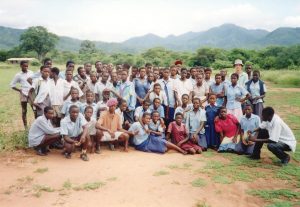Teachers’ International Service
October 8, 2015

Photo Courtesy of Mark Bradley
Living in a developing country for two years without most modern conveniences and little communication with family and friends would be unthinkable for most people, but nearly 220,000 Americans have done just that when they volunteer for the Peace Corps.
Math teacher Mark Bradley joined the Peace Corps in 1993 when he was 27 years old. He served in Zimbabwe for two years and in Cameroon for three. While volunteering in Zimbabwe, Bradley taught math and science in a rural high school. In Cameroon, he taught physics courses at a teacher training college.
“I learned about my own preconceptions, my own biases. When you live in another culture you see things through their eyes so you can step back and see yourself in a different aspect,” Bradley said.
There are several challenges that come with volunteering. Volunteers often live without electricity, running water or a nearby telephone to call home. At first, Bradley said he felt isolated.
“I wasn’t in isolation once I met people,” Bradley said. “The fondest memories are of the people. They’re incredibly generous even though they have much less than what we have monetarily. They just have this warmth and this generosity that was just unending.”
Former history teacher Heidi Hemming served in Mali for over two years when she was 24. Hemming trained teachers in local schools and assisted several of the locals, including an artist who needed help starting his business and a family who sold rabbits.
Hemming said that being in an impoverished country made her recognize her privileges. “Many Malians are very poor and are masters at fixing things. They don’t waste anything. There were times that I traveled in vehicles that were probably more duct tape than metal. It made me realize how spoiled and wasteful Americans can be,” she said.
While living without running water or electricity in an incredibly hot climate was difficult, Hemming found the change in culture to be her biggest challenge. There were many social customs she had to adjust to.
“Malian culture is very different from American culture. It is very communal; there is very little privacy. People are used to being together all the time and can’t imagine wanting to be alone. And as an American there, it is pretty impossible to blend in a�� You don’t know what the social rules are,” Hemming said.
While adjusting to the culture was difficult for Hemming, she was able to bond with the other volunteers through their shared experiences, and is still in contact with several of them. She said that she had fun working with the locals whom she described as friendly, generous and upbeat. She was surprised to see that despite living in poverty, they appeared to be much happier than most Americans.
Hemming gained a valuable perspective from her time serving. “Peace Corps helped me to see myself more as a citizen of the world. I also feel like I benefited more from the experience than anyone I tried to help. Being in a place where nothing got done quickly, I had to learn to slow down and be patient.”
Both Hemming and Bradley believe that volunteering in the Peace Corps was incredibly beneficial to them.
“I definitely think [volunteering] is worthwhile,” Bradley said. “Everybody should try it. It’s a great experience especially if you’ve never traveled abroad or lived in a different country. It’s a great eye-opener.”



